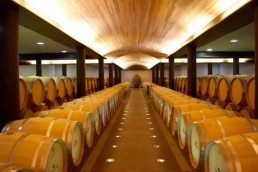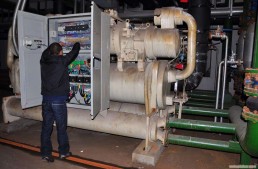Application of Coolant in wine
In order to produce high-quality wine, it is very important to control the appropriate fermentation temperature in the process of grape juice cooling, clarification and fermentation.At the same time, there are colloidal substances, Tartrates and polyphenols in the wine that has just been fermented and filtered and clarified. When the environmental temperature changes greatly, haze or even precipitation will occur, which will affect the sensory quality and flavor of the wine.In addition, the fermentation process will release a large amount of heat, which will increase the temperature and affect the quality of the wine.Based on the above process requirements, it is more appropriate to select the coolant system.
The conventional coolant is mainly ethylene glycol, propylene glycol and other coolant with good cooling effect and temperature maintenance,However, the system has some corrosion problems after a long time,There is a risk of coolant leakage into the wine, so many wine manufacturers choose propylene glycol with lower toxicity. The price of propylene glycol is generally 3-4 times that of ethylene glycol, and the production cost is increased. Finally, the corrosion problem of the system has not been solved.
Glacier coolant has provided professional coolant in many wineries, which has solved the corrosion problem of equipment,Therefore, LM-4 type coolant can be used for the selection of the carrier coolant. The price is lower than that of propylene glycol, and the specific heat, thermal conductivity and viscosity are lower than those of propylene glycol, and the operating energy consumption is also low. It is a good choice.
Low temperature treatment is to reduce the temperature of newly produced wine to – 5 ℃, increase the stability and sensory quality of wine, and reduce the acid and astringent taste.The clarification temperature is generally 5 ℃, the red wine fermentation is 24 ~ 26 ℃, the white wine fermentation is 19 ℃, the low temperature treatment temperature is – 5 ℃, and it needs to be kept for 15 days at – 5 ℃.
The glacier coolant system can control the temperature accuracy of each link, reduce the operating cost of the system, and ensure the quality of wine.
Application of Low Carbon Building Coolant
Low carbon building refers to reducing the use of fossil energy, improving energy efficiency and reducing carbon dioxide emissions throughout the life cycle of building materials and equipment manufacturing, construction and building use.
At present, low-carbon buildings have gradually become the mainstream trend in the international construction industry.An often overlooked fact is that buildings account for almost 50% of the total carbon dioxide emissions, which is much higher than that in transportation and industry.The energy control of air conditioning in summer and heating in winter is the main part of carbon emission reduction in the life cycle.
The core of how a building can achieve zero carbon emission is energy storage, which is not only limited to the storage of electric energy, but also a storage of thermal energy and cold energy.
In summer, the solar energy and thermal energy are relatively abundant. The thermal energy is stored by the coolant and indirectly converted into domestic hot water. The cold source of the air conditioner is provided by the absorption refrigeration unit. The electric power of this system will be very small. It can realize self-sufficiency through solar power generation and storage for use, and realize zero carbon emission of the air conditioner in summer.
In winter, the load of the building is divided into the inner area and the outer area. The outer area needs heating and the inner area needs cooling. This kind of system has higher requirements on the coolant. In winter, the cooling in the inner area can directly exchange heat with the outdoor air through the coolant. In addition to using solar energy, the hot water in the heating area also needs to provide a backup heat source. The backup heat source uses a heat pump for heating, so as to realize the complementation of the cold energy in the inner and outer areas. In addition, the domestic hot water also needs to be produced by a heat pump.
Coolant is very important to the coupling of building cold and heat sources.On the premise of meeting the physical property requirements, the safety performance such as toxicity and flammability must also be paid attention to.Glacier coolant environmental friendly coolant is safe and stable, For the use of zero carbon energy venues.
Maintenance of Coolant system
In air-conditioning engineering, industrial production and scientific experiments, coolant devices are often used to indirectly cool the objects to be cooled, or the cooling capacity generated by the refrigeration device is transmitted over a long distance, which can solve some problems that are difficult to be solved by direct cooling refrigeration devices.
Due to the simple operation and maintenance of the system, some problems are often ignored.There is a cold storage water tank in the secondary pump circulation system. Generally, the water tank is open and connected with the atmosphere. In the long-term use process, because the water vapor partial pressure of the air is greater than the surface partial pressure of the coolant solution, the water in the air will enter the system.For some small systems, the impact of freezing point is more obvious, so small systems need to test and record their freezing point on one side every two to three months.Due to the large volume of the large system, the opening of the water tank is treated with a breather valve. Due to the relatively small amount of water migration, the measurement and recording time can be once a year. If problems are found, they can be handled as soon as possible to reduce the cost of adjusting and distributing the coolant in the later stage.The above is mainly for the maintenance of water-soluble coolant system.
For the non water permeable coolant system, the closed system is generally considered in the design process, and the coolant storage tank is also sealed by nitrogen to prevent moisture from entering.During the operation and maintenance of such systems, it is necessary to record and compare the pressure of the system. During the equipment maintenance process, air or some impurities will inevitably enter, which will accumulate at the filter in front of the water pump and coolant heat exchanger, and the moisture in the air will become ice. At this time, the pressure at the inlet of the pump will be low. If it is lower than the atmospheric pressure, air will invade the system and produce a vicious cycle, Therefore, this item needs to be included in the inspection process of the system.
Although the operation and maintenance of the coolant system is simple, it still needs fine management. Glacier coolant focuses on the coolant and application system, and provides professional operation and maintenance solutions.



